13 Best Substitutes for Shiitake Mushrooms
When you buy through our links, The Breslin may earn an affiliate commission. Learn more
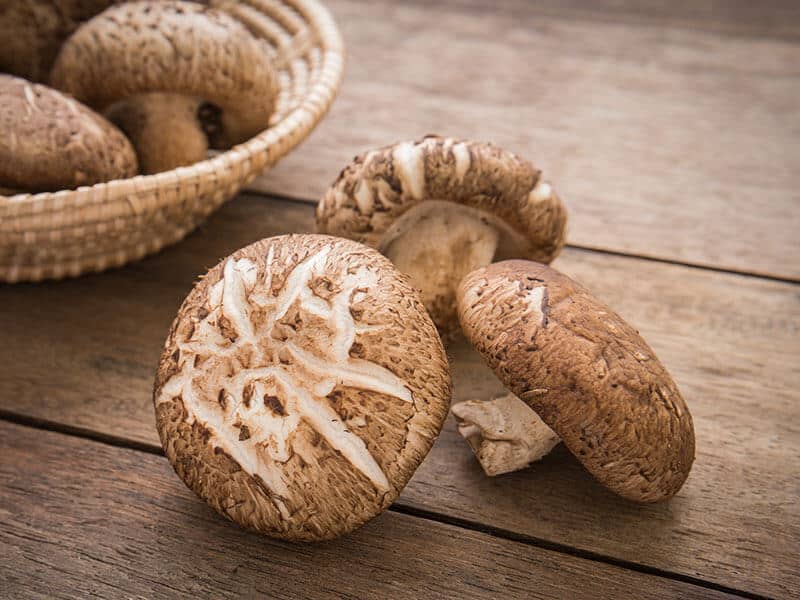
Shiitake mushroom substitute? Shiitake mushrooms are a sought-after item. I used to get upset when I couldn’t get my favorite shiitake mushroom since I came home very late and could only go to my nearby supermarket in the late afternoon.
Substituting them with other kinds of mushrooms is the only way I can do. But you know what? By somehow, my recipes work absolutely well with these alternatives!
If you are having problems figuring out a suitable replacement for the shitake mushrooms, don’t look any further. In this article, I will tell you to know more than ten options. All you need to do is dig into the information below and pick the best ones!
Shiitake Mushrooms – The World Favored Delicacy
Let’s take a quick look at the basic information of shiitake mushrooms first. In particular, knowing their flavor or uses will help you to make the right decision when considering other replacements.
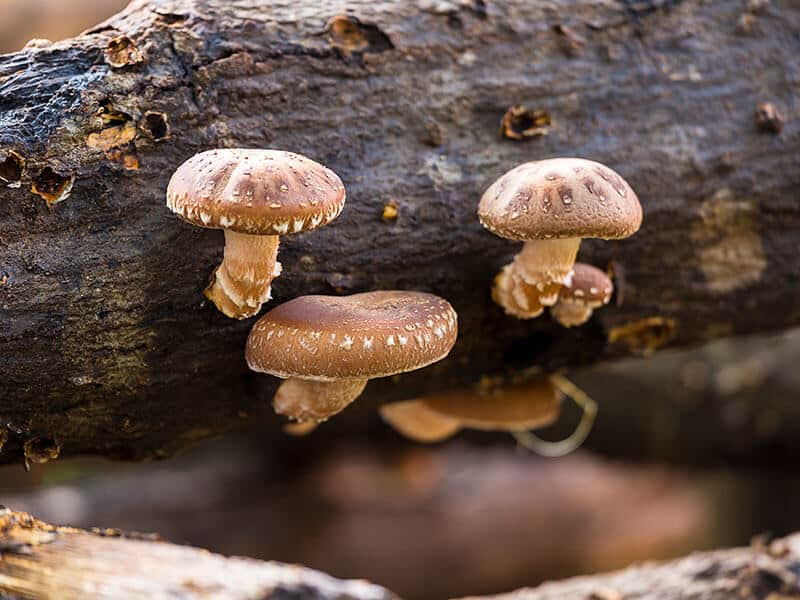
1. What Are Shiitake Mushrooms?
Shiitake mushrooms, or also known as black forest mushrooms, “golden oak mushroom,” or “oakwood mushroom,” is a kind of edible mushroom belonging to the Omphalotaceae family. They are found to grow mostly in decaying wood logs around East Asian regions.
In Japanese, this mushroom is named under the name of “shii” – a hardwood tree they originally grow on (and “take” means mushroom). Shiitake mushrooms have light to dark brown caps that can develop between 2 and 4 inches with a slender but tough stem.
Due to the aromatic flavor, people try to find new techniques for cultivating this mushroom, including using corncobs and sunflower seed hulls as the growing media.
On the other hand, they are also cultivated in rotting wood of chinquapins, oak, maple, poplar, chestnut, or beech in moist climates, which are considered the most appropriate natural environment for better development.
Shiitake mushroom is ranked as the third worldwide cultivated mushroom (behind the white button and oyster mushroom). And the biggest provider is absolutely Japan since around 83% of shiitake mushrooms are harvested every year.
Do you want to know when shiitake mushrooms are harvested?
2. What Do Shiitake Mushrooms Taste Like?
The first thing you will notice about shiitake mushrooms’ texture must be their water content. Compared to other cousins, this mushroom has only approximately 75% of water, resulting in a more chewy texture. But once cooked properly, they’re very tender, velvety, and juicy.
And when it comes to the taste, shiitake mushrooms are the king. Thanks to the presence of the amino acid glutamate, they give off a rich umami flavor. Not only that, but shiitake mushrooms also are packed with earthy, buttery, and meaty with a hint of smokiness.
In addition, although shiitake mushrooms can be eaten raw, they will taste more pronounced and flavorful when they are cooked.
3. Various Culinary Uses Of Shiitake Mushrooms
If any of you ask me for the most versatile kind of mushroom, it is obviously shiitake mushrooms.
Why do I say that? Because these mushrooms show their face up in many recipes. Except for being sauteed or stir-fried as an independent dish, you either can find them as a flavor-boosting ingredient in soup, sauces, stews or braises, and rice dishes.
In Particular, shiitake mushrooms are one of the essential parts of Japanese miso soup. Moreover, it also goes well in many iconic Italian delicacies such as risotto and pasta.
As shiitake mushrooms contribute a meaty richness to the recipes, they are widely used as a substitute for meat in vegetarian diets too. For example, Buddha’s delight – a delicious Chinese vegetable and tofu mixture also has shiitake mushrooms in its recipe.
Sauteed shiitake mushrooms are an all-time classic treat. You can see this video to know more:
Conversion Ratios Between Shiitake Mushrooms And 13 Alternatives
Before going to the main part of this post, you can take a glance at this conversion table below for clearer ratios of shiitake mushrooms and their 13 replacements.
13 Need-To-Be-Considered Shiitake Mushrooms Substitutes
In this section, I will give you basic information about each available option you can use to replace your run-out shiitake mushrooms. Also, I will tell you which recipes you should put them in to get the most shiitake-like flavor.
1. Portobello Mushrooms
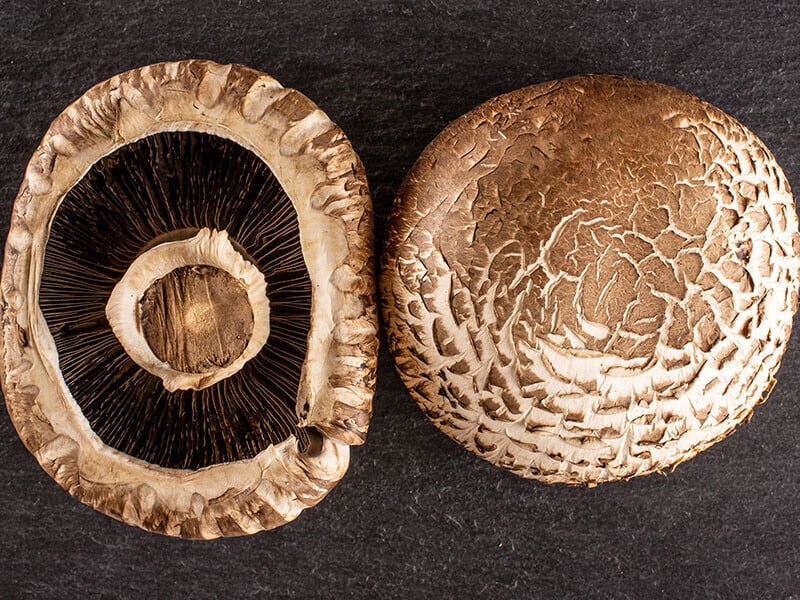
Like shiitake mushrooms, I could gobble up a whole plate of portobello mushrooms in just a few minutes. There’s no doubt that it is one of my most favorite substitutes. As for its popularity, you can easily kidnap them at a nearby grocery store and add them to your dish.
There must be a reason for this mushroom as an excellent replacement for shiitake mushrooms, right? Well, since portobello mushrooms offer a smooth, thick, and chewy but shiitake-like tender texture, you can be sure that nothing can go wrong with this option.
Not only that, but the flavor profile of this mushroom is also super similar to shiitake mushrooms.
It brings you an almost duplicated meaty and earthy notes but holds a richer, stronger umami flavor and smoky scent. You will want to use it in stews, soups, sauces, salads, risottos, pizza, burgers, and pasta.
Note: Portobello mushrooms have a quite firm texture when raw. As a result, they need to be cooked extensively to achieve the expected tender texture.
2. White Button Mushrooms
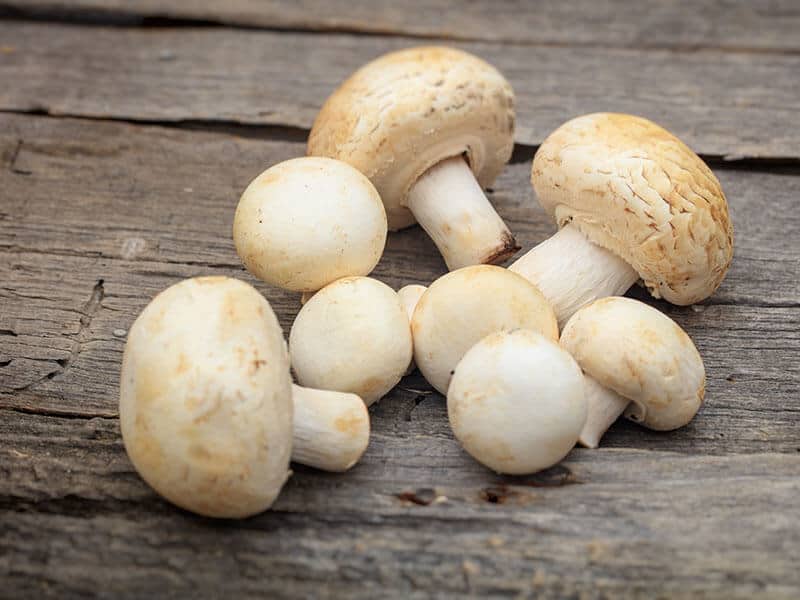
White button mushrooms are the most popular mushroom variety, accounting for about 90% of the mushrooms consumed in the American market.
Like cremini mushrooms, they are the youngest brother of portobello mushrooms. In other words, white button mushrooms are portobello mushrooms but harvested at the earliest stage of maturity. The distinctive off-white color sets them apart from portobello ones.
When cutting raw, you can find that this youngest brother has a firm, smooth, and spongy texture. They are not as chewy as portobello mushrooms and even don’t taste chewy at all if being cooked for a long time.
When cooked, white button mushrooms can be incredibly soft and buttery.
And because of being harvested in the earliest stage, these mushrooms taste milder, less earthy, and far less intense. You also will find some nutty and peppery flavor with a very fresh and pleasant aroma.
I love caramelized white button mushrooms. They are breathtakingly delicious. You can roast or grill them all. Besides, don’t hesitate to add them raw to your salads, use them for cooking carpaccio, eating them with pasta, omelets, etc.
You know, there are a thousand mouth-watering treats for these lovely sweethearts.
3. Cremini Mushrooms
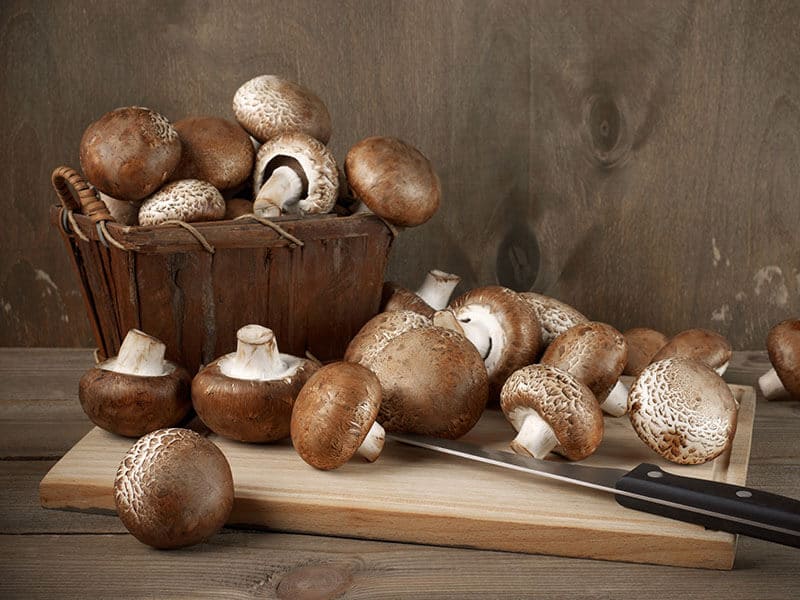
Cremini mushrooms, sometimes referred to as “baby portobellos,” are actually the portobello mushrooms. More precisely, they are the younger version of portobello mushrooms. Cremini mushrooms are in the middle of maturity.
Their age lies between the white button and portobello ones, resulting in a light brown instead of white or dark brown color. And by using cremini mushrooms, you can have a slightly softer, smoother, and more delicate consistency.
And even though cremini mushrooms have low water content, they still can give you a rich and deep umami flavor. Compared to shiitake mushroom, this substitute holds a milder savory taste with woodsy and subtly earthy notes and a nutty undertone.
Sauteeing is the best treat for cremini mushrooms as they can make the flavor even more pronounced. Furthermore, you can add them to your stews, sauces, pasta, risotto, rice, and poultry recipes.
Note: When buying cremini mushrooms, check out the gills. If they still are covered, they are freshly harvested.
Make your cremini mushrooms taste their best with this simple recipe!
4. Porcini Mushrooms
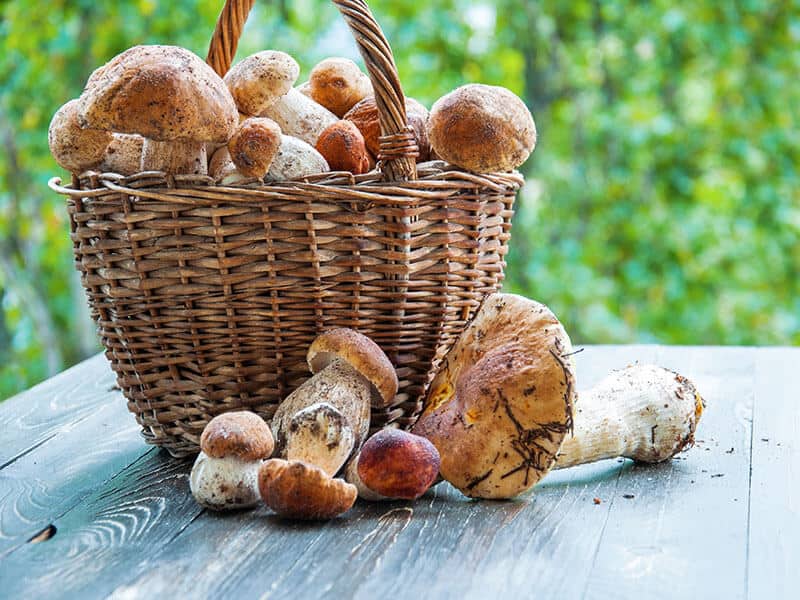
Porcini mushrooms are very welcomed in European cuisines, especially French and Italian cuisines. They are the muse in many delicacies, from pasta, risotto, brown sauces to soups, salads, dumplings, grilled steaks, rice, and porridge dishes.
And no matter you stir-fry, fry, sauteed, bake, grill, or stew them, they all will not make you feel disappointed.
Porcini mushrooms themselves give off a deep, robust, earthy, woodsy, and nutty flavor. Don’t worry. Your dishes will not be overwhelming. The rich and savory tastes are what you will love about these caramelized-brown, cute round mushrooms.
And in case you need a chewy texture like shiitake mushrooms in your dishes, porcini ones will never be a bad pick. But don’t be misunderstood. These mushrooms also can be very tender, thick, and silky, as you expected, when cooked correctly.
Plus, don’t forget to discard their stems and the vertical tubes when cooking.
5. Oyster Mushrooms
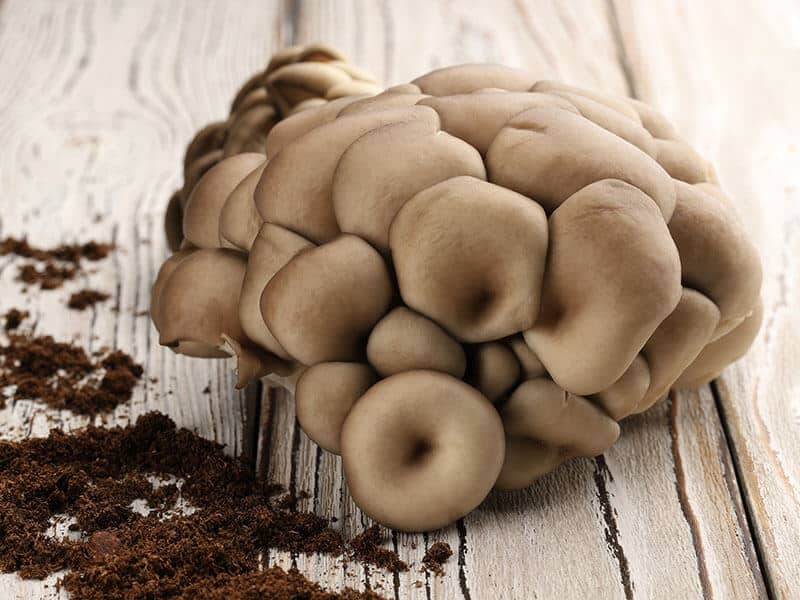
Oyster mushrooms are not an often-seen variety in America. They are more prominent in Asian markets, such as Japan, Korea, and China. However, if you have them on hand now, replace them with your run-out shiitake mushrooms.
It is a fact that oyster mushrooms come in various kinds, and each type will have slight changes. The two most well-known varieties are pearl oyster and king oyster.
Pearl oyster mushrooms are often sold in bulk. They have a tender texture with a more gentle, sweeter and woodsy taste.
Whereas, in king oyster, you will get a thicker, meatier, more chewy texture and more seafood-like flavor. In some recipes, you also may find a very sour tone at the end of the tasting.
The biggest drawback of this alternative is that it doesn’t offer an as strong earthy flavor as shiitake mushrooms do. And when it comes to cooking, you may need extra time to cook oyster mushrooms and carefully watch them to avoid burning.
Also, soak oyster mushrooms in water for a few hours to get rid of the hidden insects and keep their velvet texture. Oyster mushrooms are very suitable for liquid-based dishes. In addition, you can serve them with fish, steak, and burgers to enjoy the full richness.
Of course, adding them to pizza, pasta, rice, and pies will not ruin your dishes too.
Want to grow oyster mushrooms? It’s not as hard as you thought!
6. Maitake Mushrooms
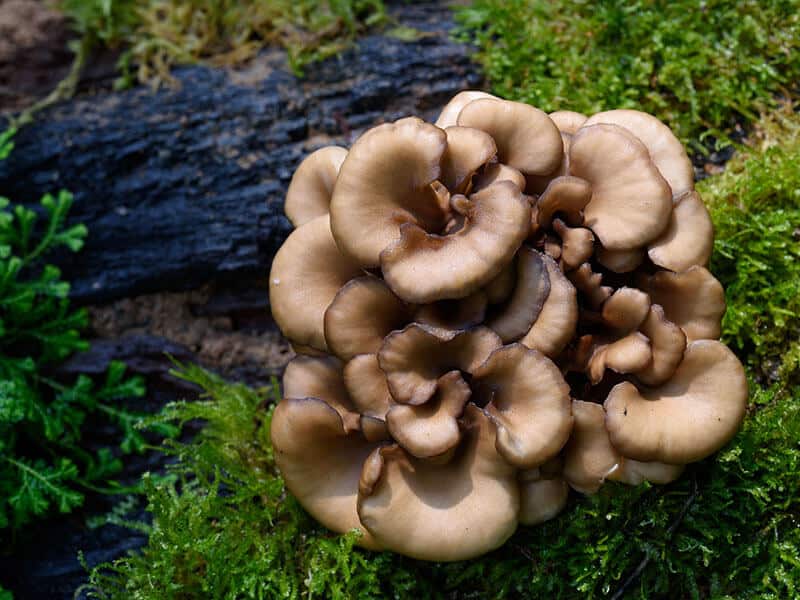
Maitake mushrooms, like shiitake mushrooms, are found widely in Japan and other Asian countries. This is a kind of polypore mushroom, mostly found to be attached at the base of oak trees.
In Japanese, maitake literally translates as “dancing mushroom” since there is a rumor that people will dance in joyfulness when they find these mushrooms in nature. And I also believe that it is because they look like the dress of dancers when dancing.
Different from shiitake, maitake mushrooms will be more favored by those who love a more delicate flavor. This replacement, on the other hand, will not give a meaty and hearty taste. In return, they will offer you the same deep earthy, and savory flavor as the shiitake ones.
And you know what? The sweet undertone and a peppery note will make maitake mushrooms even more uniquely flavorful. With a little bit of chewy texture, maitake will not be easy to overcook and still can keep its texture well in long-time cooking.
Let’s go for pan-frying, boiling, steaming, or grilling when you decide on this substitute. Pair maitake mushrooms with omelets, soup, salad, sauces, vegetable dishes will be the best treats you can consider.
7. Lobster Mushrooms
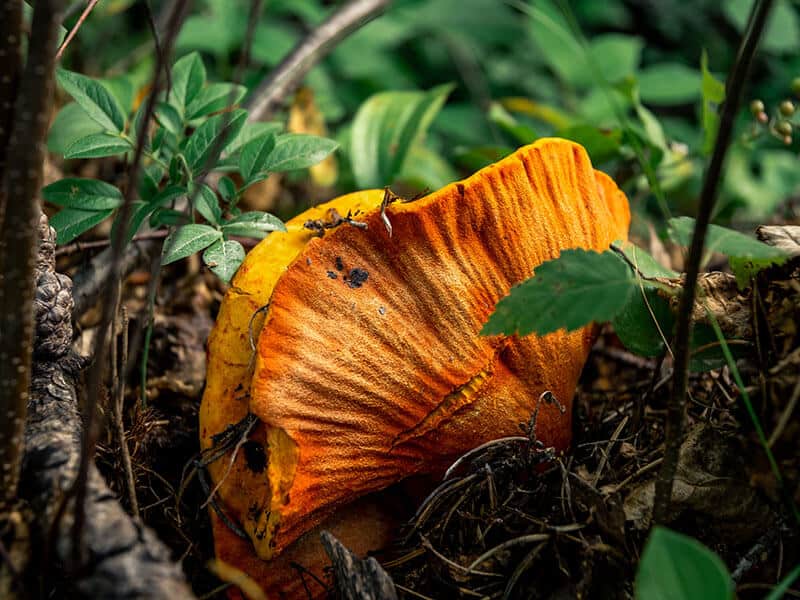
As its name suggests, lobster mushrooms are identified with an eye-catching reddish-orange color that reminds you of the outer shell of a cooked lobster. Lobster mushrooms are developed from the parasite Hypomyces lactifluorum.
More specifically, this parasite invades wild mushrooms (lactarius and russula) and turns them into the thing people call lobster mushrooms.
Lobster mushrooms may look quite strange and coarse, but their texture is a whole different story. They are dense but rather crisp and brittle. You should not expect a chewy texture like when you cook with shiitake mushrooms.
Nevertheless, don’t hurry to give up on this option since you will get some flavor of shiitake. By using lobster mushrooms, you will achieve the umami-rich, earthy and meaty taste. Besides, it also adds a kick of mildly sweet, woody, and nutty flavor to your food.
I usually enjoy them as a standalone dish. But you totally can substitute them in the stews, soups, sauces, meat, or fish recipes. Additionally, if you are going to mash, fry, or bake your potatoes, well, you know what I mean, right? Go for it!
8. Enoki Mushrooms
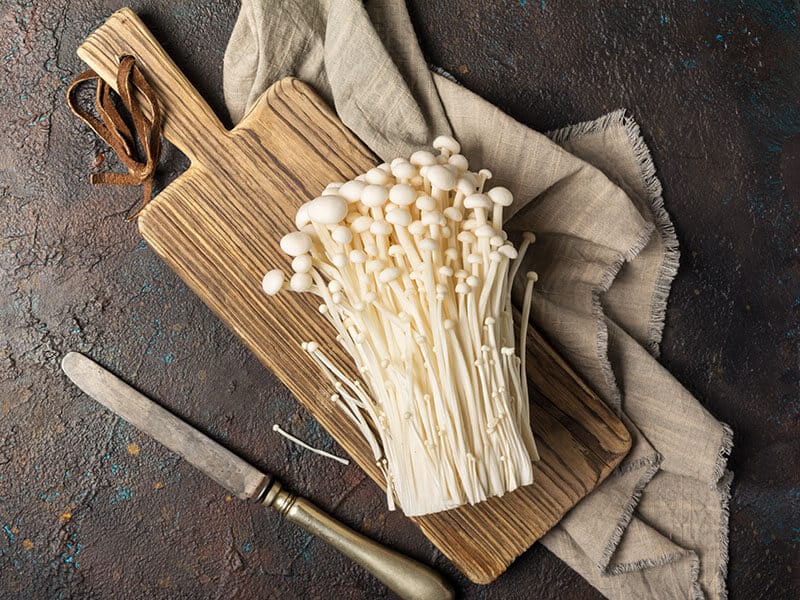
In Chinese, enoki mushrooms, also called “golden needle mushrooms” or “lily mushrooms,” have become one of the most favorite varieties around Asia in modern cooking.
In recent years, enoki mushrooms have started to be consumed more in the United States due to the strong development of Asian cuisine. I am a big fan of enoki mushrooms since they go perfectly with every kind of my favorite hot pot, soups, noodles, and salads.
If you want to have an outstanding replacement in meat dishes like beef, pork, or veal, don’t look any further, the perfect solution is now in front of your eyes. Also, don’t forget to give them a chance in grilling, roasting, stir-frying, and boiling recipes!
For more information about the flavor, enoki mushrooms tend to be more delicate and gentle. On the other hand, the earthy flavor and aroma will not be as robust as shiitake; you will love to have them if you prefer a milder taste in your recipes.
Before you do anything with this replacement, keep in mind that it has a more chewy texture when raw. Hence, cook them for a few minutes (don’t cook them too long) to reduce the chewiness.
Remember to add enoki mushrooms into your favorite Korean hot pot!
9. Dried Shiitake Mushrooms
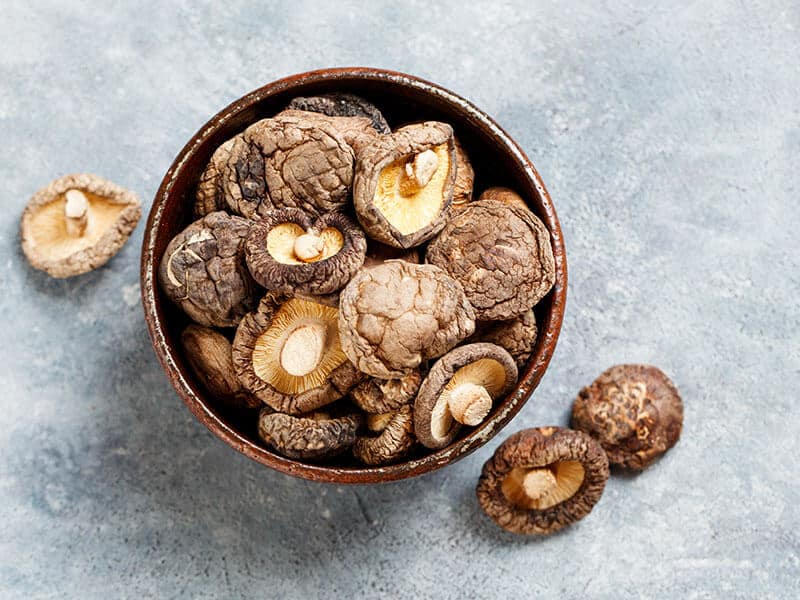
In case you have no fresh mushroom-based option above, you definitely should give the dried version of shiitake mushrooms a chance.
Though the dried shiitake mushrooms are more likely to be tough and lose natural juiciness than the fresh shiitake mushrooms and other fresh replacements, they still can bring you the exact shiitake-like flavor to your dish.
The only difference here is the dried version will offer a more intense and concentrated flavor with a stronger fragrance than the fresh version. Use them interchangeably in soups, stews, or stir-fried dishes to get the best flavor.
And remember not to add them to your salads.
Note: Before using, soak them for 15 – 20 minutes in warm or boiled water until they are double in size. Then, rinse them carefully and cut them according to your preference.
10. Tempeh
Tempeh is a fermented soybean-made product served in traditional Javanese cuisine – an ethnic group in Indonesia for thousands of years. It started to appear in Western cuisine in the 1970s as a substitute for meat in vegan diets.
It might sound strange to use a non-related mushroom substitute in recipes calling for shiitake mushroom. But believe me. It really does work! Tempeh is described to have a shiitake-like taste with a firm texture and a strong, nutty but subtle meaty and earthy flavor.
And when you use tempeh, you definitely can expect a rich umami flavor on your plate too. It will be great once you put this alternative into pasta, tacos, casserole, or several kinds of sauces.
While it is better to be fried, deep-fried, or stir-fried to get a better taste, some recipes will require you to soften the tempeh by steaming or simmering it for around 10 minutes. You may need to cut tempeh in cubes or 3/4-inch thick slices before cooking it.
11. Tofu
Come on; I bet you know it, don’t you? Everyone knows about tofu! Originating from China a thousand years ago, tofu, also known as soybean curd, has been expanding its influence worldwide.
Tofu texture depends on various kinds of tofu. However, in general, they are very soft. Tofu itself has a mildly sweet, but almost bland flavor in general. But once you mix it with soy sauce or lemon juice, you may receive a quite similar creamy flavor and woodsy taste.
Tofu is a safe option that will never turn your plate into disasters if you accidentally add too much to your dishes. As mushrooms, tofu varies in use too. It can be fried, roasted, baked, or put into the hot pot, soups, pasta, or rice dishes.
Note: Tofu is a wheat-free and gluten-free substitute also if you use the traditional plain tofu.
12. Eggplant
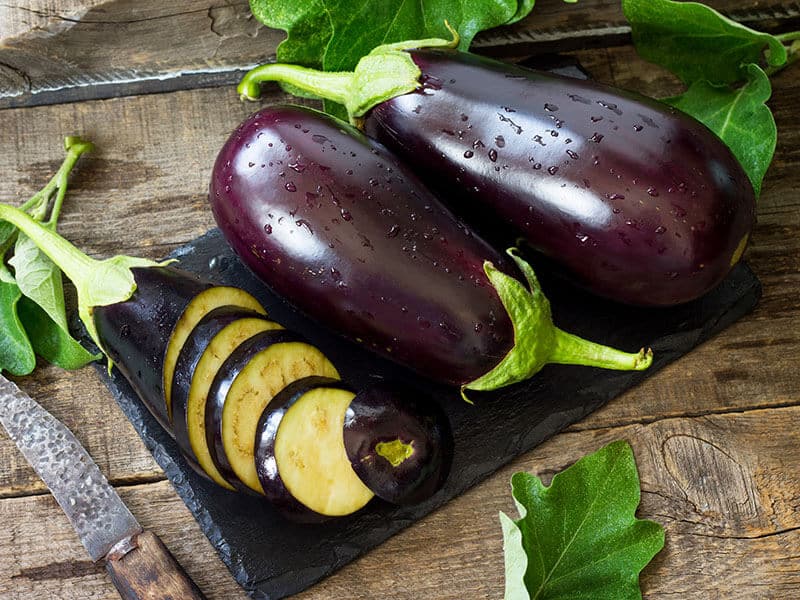
If you are a big fan of Italian eggplant parmesan, I’m sure you are no stranger to this replacement. This vegetable is a member in the nightshade family, the cousin of tomato, zucchini, and okra.
Eggplant appears mostly in Asian and European cuisine. You can easily distinguish it by the signature smooth and shiny purplish-black skin. When you eat it raw, you will find it is quite firm and spongy. In contrast, eggplant is super tender, creamy, and juicy when cooked.
When eaten raw, eggplant tastes quite bitter but not overwhelming. On the other hand, eggplant is said to have a mild but richer meaty flavor when cooked, which explains why it is often listed in the mushroom’s substitute collection.
A bonus for those who choose this option is the sweet note and spicy aftertaste. It means you don’t need to add more pepper to your food.
What about the best treats? Well, not only can you grill it, bake it, fry it, blend it into dips or spreads, but you also can combine it with garlic, bell peppers, onions, and other aromatic herbs.
And once you braise eggplant, it will absorb all the flavor from the other ingredients it’s cooked with.
Note: Don’t overcook your eggplant, or you will end up with a mushy consistency.
Trust me. Love at first taste is real when it comes to miso and chili braised eggplant!
13. Zucchini
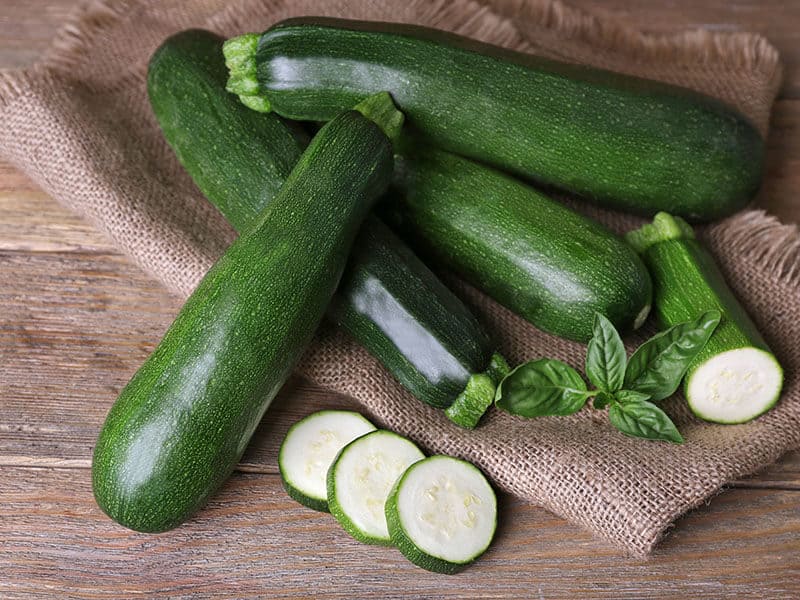
As mentioned above, zucchini belong to the same nightshade family as eggplant. It is the most easy-to-find and budget-friendly substitute you can find since it is very common in both the European and American culinary world.
Zucchini is not a perfect choice for the position of shiitake mushroom substitute because of many differences in the flavor profile. Nonetheless, it still works fine in some recipes.
Using zucchini means you will need to accept the sweet, and savory flavor with a mild vegetal taste and woodsy smell. In terms of texture, it is more tender, juicier, and not chewy at all.
Zucchini is an extremely versatile replacement. Besides adding more moisture to your bread, it also can be a good pick in pizza, pasta, cheeses, soup, frittata, cereals, quiche, poultry, and other divine meat recipes.
Health Benefits: What Can Shiitake Mushrooms Do For You?
You may be surprised that shiitake mushrooms are also used in medical treatment. And as a healthy food, you will want to know more about the amazing benefits these mushrooms bring to your body.
1. Strengthen Your Immune System
As reported from a study conducted in 2015, shiitake mushrooms can help to improve the human immune system. More specifically, there is a significant decrease in inflammation levels in 52 participants who eat dried shiitake for 4 weeks. (1)
This may be due to one of the polysaccharides’ appearances contained in this mushroom. (2)
2. Good For Your Heart
Shiitake mushrooms are highly appreciated and added to diets as a heart-healthy food. It is used as a meat alternative because of the low sodium level with the absence of saturated fats. (3)
Additionally, it helps to control blood pressure and reduce cholesterol levels as well.
3. Protect You From Gingivitis
It is a surprise that shiitake mushrooms also act as medicinal mushrooms, which help to prevent gingivitis.
By reducing the harmful bacteria in your mouth – one of the causes leading to oral complications (periodontal disease, for example), shiitake mushroom extract protects your teeth from soft tissue damage, bad breath, and gum bleeding. (4)
4. Other Noticeable Health Benefits
Excluding the above findings, shiitake mushrooms also promise many other health benefits. It is demonstrated to be useful in fighting obesity, destroying cancer cells, improving brain function, supporting skin healing, promoting digestive and gut health.(5)
FAQs
You still have some other questions that need to be answered? Then look at these frequently asked questions below. Just a few minutes to get the problem solved!
Make Cooking Easy With These Brilliant Alternatives
With the introduction of Asian delicacies in the United States, shiitake mushrooms nowadays are no longer limited to Japanese or Asian cuisine. They show their face up in many of your favorite recipes and almost make every Asian food lover’s menu their home.
However, if you suddenly find them out of stock when going for purchase in the nearby supermarket, my post today can be helpful. Don’t forget to read the information I put here carefully to make the best decision.
As long as you go for the right recipes, all problems can be solved. Finally, I would be really glad if I could help you with my post here. Please leave a comment below to let me know your opinion.
References
- Dai, X., Stanilka, J. M., Rowe, C. A., Esteves, E. A., Nieves Jr, C., Spaiser, S. J., … & Percival, S. S. (2015). Consuming Lentinula edodes (Shiitake) mushrooms daily improves human immunity: A randomized dietary intervention in healthy young adults. Journal of the American College of Nutrition, 34(6), 478-487. Available at: https://www.tandfonline.com/doi/abs/10.1080/07315724.2014.950391
- Xu, X., Yang, J., Luo, Z., & Zhang, X. (2015). Lentinula edodes-derived polysaccharide enhances systemic and mucosal immunity by spatial modulation of intestinal gene expression in mice. Food & function, 6(6), 2068-2080. Available at: https://pubs.rsc.org/en/content/articlelanding/2015/fo/c4fo01192a/unauth
- Rop, O., Mlcek, J., & Jurikova, T. (2009). Beta-glucans in higher fungi and their health effects. Nutrition reviews, 67(11), 624-631. Available at: https://academic.oup.com/nutritionreviews/article/67/11/624/1850752
- Ciric, L., Tymon, A., Zaura, E., Lingström, P., Stauder, M., Papetti, A., … & Spratt, D. (2011). In vitro assessment of shiitake mushroom (Lentinula edodes) extract for its antigingivitis activity. Journal of Biomedicine and Biotechnology, 2011. Available at: https://www.hindawi.com/journals/bmri/2011/507908/
- Christine Ruggeri. Shiitake mushrooms: 9 scientifically proven benefits you need to know about. Draxe.com.. Available at: https://draxe.com/nutrition/shiitake-mushrooms/

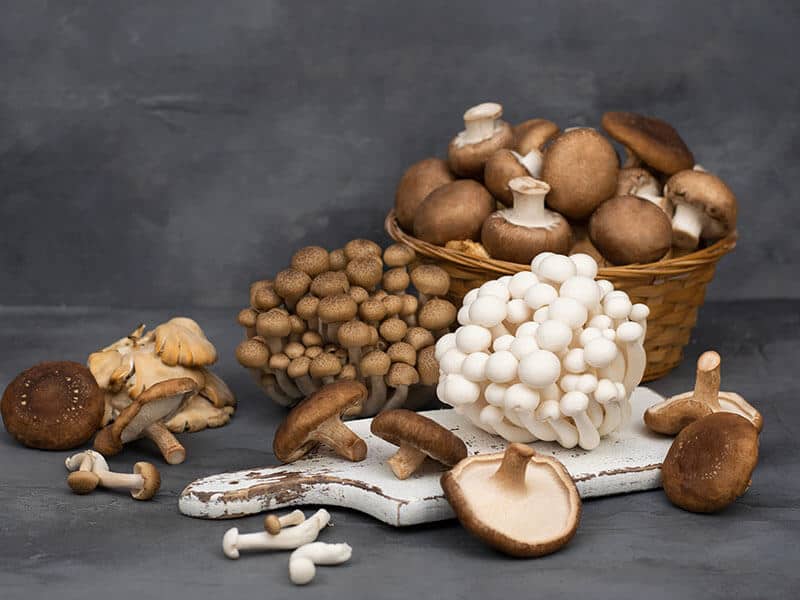

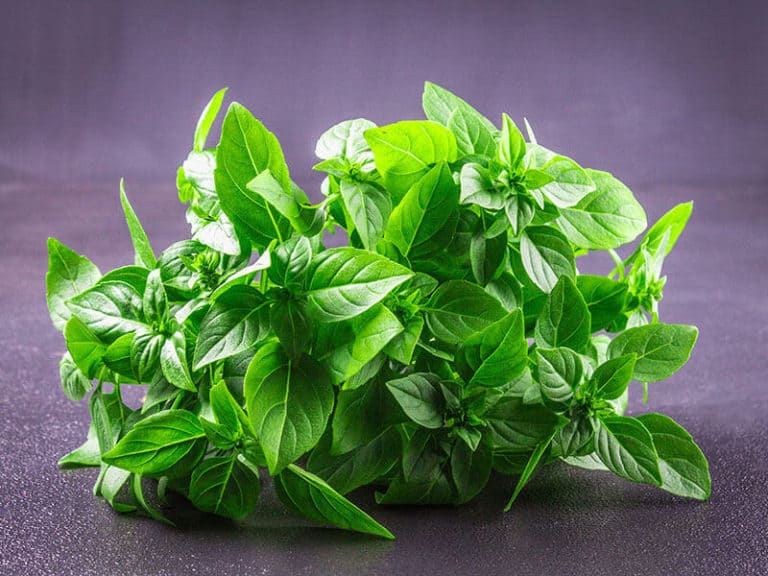
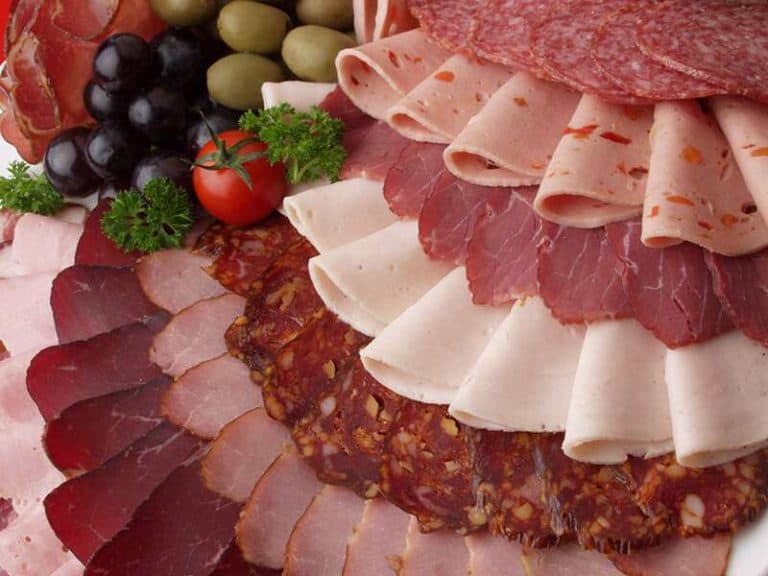
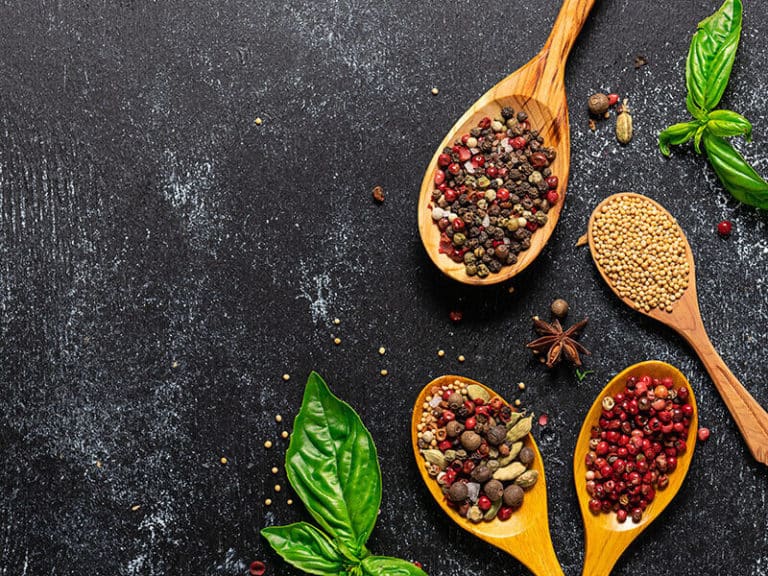
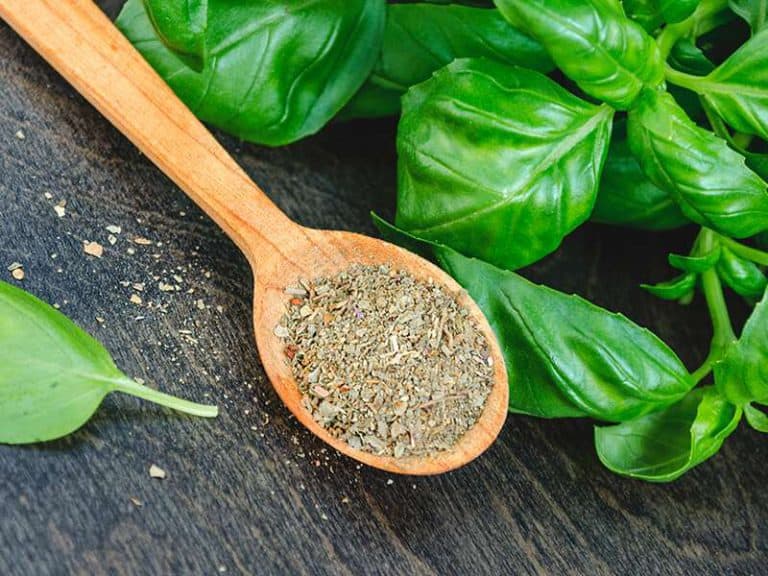
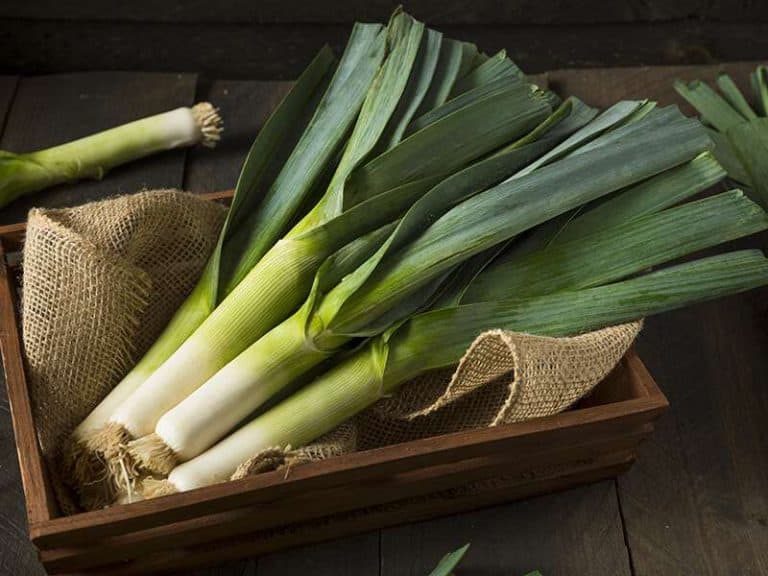
Amanda Collins
Founder and Senior Culinary Editor
Expertise
Culinary Arts and Management, Food Journalism and Critique, Recipe Development and Testing, Global Culinary Traditions, Sustainable Food Practices
Education
Institute of Culinary Education (ICE), New York, NY
Program: Diploma in Culinary Arts
Focus: Intensive hands-on training in culinary techniques, recipe development, and kitchen management, preparing students for professional roles in the culinary industry.
Monroe College, New Rochelle, NY
Program: Associate in Applied Science in Culinary Arts
Focus: Practical culinary skills, including cooking techniques, menu planning, and kitchen operations, with an emphasis on hands-on experience and industry standards.
Amanda Collins is a seasoned chef and food editor with a deep love for global flavors. Trained at the Institute of Culinary Education and Monroe College, and with over 15 years in the culinary field, Amanda has refined her skills in kitchens worldwide. Her background in food studies gives her a unique ability to share both recipes and the cultural stories that shape them.
As senior culinary editor at thebreslin.com, Amanda’s work brings authentic dishes to life, inviting readers to explore new flavors and techniques from around the globe. Her approachable style makes it easy for anyone to bring a bit of the world’s cuisine into their kitchen.